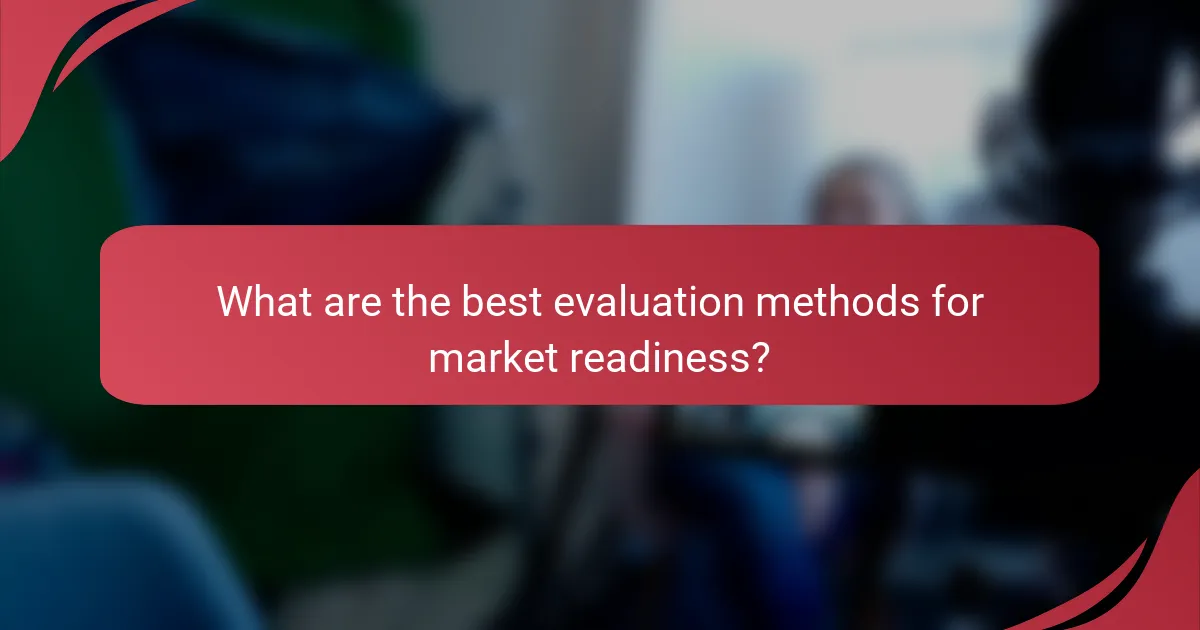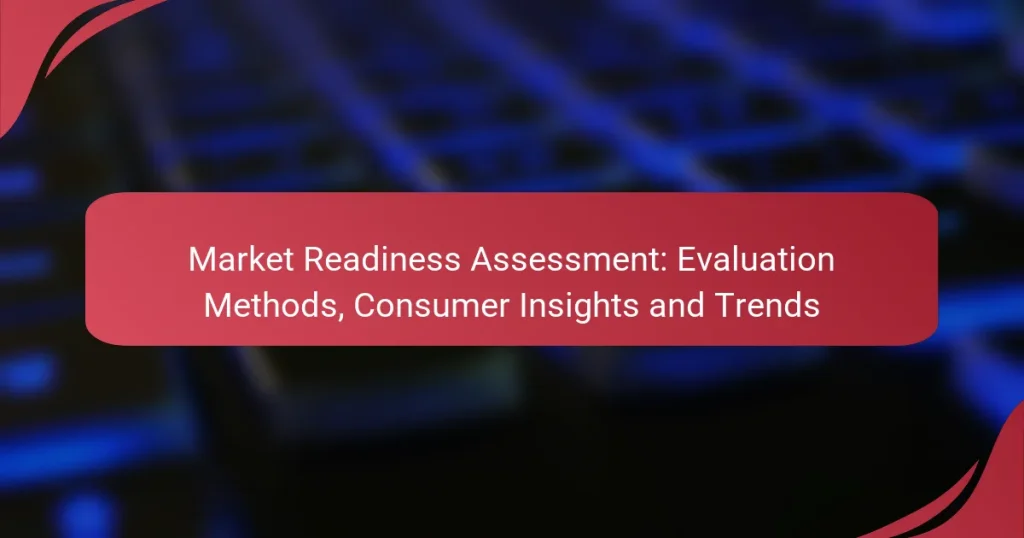A market readiness assessment is essential for determining if a product or service is ready for launch in a specific market. By evaluating consumer demand, competitive dynamics, and operational capabilities, businesses can make informed decisions. Utilizing both qualitative and quantitative research methods, along with consumer insights, enables companies to align their offerings with market expectations and enhance their chances of success upon entry.

How to conduct a market readiness assessment?
A market readiness assessment evaluates whether a product or service is prepared for launch in a specific market. This involves analyzing various factors, including consumer demand, competitive landscape, and operational capabilities.
Step-by-step evaluation process
Begin by defining the target market and identifying key consumer segments. Conduct thorough market research to gather data on consumer preferences, trends, and potential barriers to entry.
Next, assess the competitive landscape by analyzing existing competitors, their strengths, weaknesses, and market positioning. This will help identify opportunities for differentiation.
Finally, evaluate internal capabilities, including production, distribution, and marketing resources, to ensure alignment with market demands. A checklist can help track these steps effectively.
Key metrics to analyze
Focus on metrics such as market size, growth rate, and customer acquisition costs. Understanding these figures will help gauge potential profitability and market viability.
Additionally, consider customer satisfaction scores and brand awareness levels. These metrics provide insights into consumer sentiment and readiness to adopt the product.
Finally, evaluate operational metrics, such as supply chain efficiency and production capacity, to ensure that the business can meet anticipated demand without delays.
Tools for assessment
Utilize market research tools like surveys and focus groups to gather consumer insights. Online platforms can facilitate data collection and analysis, making it easier to interpret results.
Analytical software can help visualize data trends and competitive analysis. Tools like SWOT analysis and PESTEL analysis are useful for assessing internal and external factors affecting market readiness.
Consider leveraging CRM systems to track customer interactions and feedback, which can provide valuable information for refining your market strategy.

What are the best evaluation methods for market readiness?
The best evaluation methods for market readiness include qualitative and quantitative research techniques, as well as comparative analysis frameworks. These methods help businesses assess their products or services against market demands, consumer preferences, and competitive landscapes.
Qualitative research techniques
Qualitative research techniques focus on understanding consumer behaviors and motivations through in-depth insights. Methods such as focus groups, interviews, and ethnographic studies allow businesses to gather rich, descriptive data that highlights consumer attitudes towards a product.
To effectively utilize qualitative techniques, ensure that your sample size is manageable, typically between 5 to 15 participants for focus groups. This allows for deeper discussions and more nuanced feedback. Avoid leading questions to ensure unbiased responses.
Quantitative research techniques
Quantitative research techniques involve the collection and analysis of numerical data to identify trends and measure market readiness. Surveys and questionnaires are common tools, enabling businesses to gather data from larger sample sizes, often ranging from hundreds to thousands of respondents.
When designing quantitative studies, use closed-ended questions for easier analysis and to facilitate statistical comparisons. Aim for a confidence level of 95% with a margin of error of 5% for reliable results. Be cautious of survey fatigue; keep surveys concise to maintain participant engagement.
Comparative analysis frameworks
Comparative analysis frameworks allow businesses to evaluate their offerings against competitors or industry benchmarks. Techniques such as SWOT analysis (Strengths, Weaknesses, Opportunities, Threats) or Porter’s Five Forces can provide insights into market positioning and readiness.
When conducting comparative analyses, focus on key performance indicators relevant to your industry, such as pricing, market share, and customer satisfaction. Regularly update your analysis to reflect changing market conditions and consumer preferences, ensuring that your strategies remain relevant and effective.

What consumer insights drive market readiness?
Consumer insights are critical for assessing market readiness as they reveal preferences, behaviors, and needs that inform product development and marketing strategies. Understanding these insights helps businesses align their offerings with consumer expectations, ultimately enhancing market entry success.
Understanding consumer behavior
Understanding consumer behavior involves analyzing how individuals make purchasing decisions and what influences those choices. Factors such as cultural background, social influences, and personal preferences play significant roles in shaping behavior. For instance, a brand targeting environmentally conscious consumers may emphasize sustainability in its messaging.
To effectively gauge consumer behavior, businesses can utilize surveys, focus groups, and social media analytics. These tools provide valuable data on consumer attitudes and motivations, helping companies tailor their strategies accordingly.
Identifying target demographics
Identifying target demographics is essential for market readiness as it allows businesses to focus their efforts on specific consumer groups. Key demographic factors include age, gender, income level, and geographic location. For example, a tech company may target millennials in urban areas who are more likely to adopt new technologies.
Segmentation can be done through market research and analysis of existing customer data. By understanding the characteristics of their ideal customers, businesses can create targeted marketing campaigns that resonate with their audience.
Analyzing purchasing trends
Analyzing purchasing trends helps businesses understand how consumer preferences evolve over time. This analysis can reveal seasonal patterns, shifts in demand, and emerging product categories. For instance, an increase in online shopping during the holiday season may indicate a need for enhanced digital marketing strategies.
To stay ahead, companies should regularly review sales data, monitor competitor activities, and keep an eye on industry reports. Recognizing these trends allows businesses to adapt their offerings and marketing approaches to meet changing consumer needs effectively.

What are the current trends in market readiness?
Current trends in market readiness focus on the integration of technology, evolving consumer preferences, and strategic market entry approaches. Companies must adapt to these trends to effectively position themselves and meet consumer demands.
Emerging technologies impact
Emerging technologies significantly influence market readiness by enabling faster product development and enhancing customer engagement. Innovations such as artificial intelligence, blockchain, and the Internet of Things (IoT) allow businesses to streamline operations and gather valuable data.
For instance, AI can analyze consumer behavior patterns, helping companies tailor their offerings. Businesses should consider investing in these technologies to stay competitive and responsive to market changes.
Shifts in consumer preferences
Shifts in consumer preferences are crucial for assessing market readiness, as they dictate product features, pricing, and marketing strategies. Today’s consumers prioritize sustainability, personalization, and convenience, which necessitates a shift in how products are developed and marketed.
Companies should conduct regular surveys and focus groups to understand these evolving preferences. Adapting to these changes can lead to higher customer satisfaction and loyalty, ultimately impacting sales positively.
Market entry strategies
Effective market entry strategies are vital for ensuring successful product launches. Businesses should evaluate various approaches, such as direct entry, partnerships, or franchising, based on their resources and market conditions.
Consider conducting a SWOT analysis to identify strengths, weaknesses, opportunities, and threats in potential markets. This analysis can guide decision-making and help mitigate risks associated with new market entries.

How to interpret consumer feedback for market readiness?
Interpreting consumer feedback is essential for assessing market readiness, as it reveals how potential customers perceive a product or service. Understanding their insights helps businesses make informed decisions about adjustments needed before launch.
Methods for gathering feedback
Effective methods for gathering consumer feedback include surveys, focus groups, and social media monitoring. Surveys can be distributed online or in-person, allowing you to reach a broad audience quickly. Focus groups provide deeper insights through guided discussions, while social media monitoring captures real-time reactions and sentiments.
Consider using a mix of qualitative and quantitative approaches. For example, online surveys can yield numerical data, while focus groups can uncover nuanced opinions. Aim for a diverse sample to ensure feedback represents different segments of your target market.
Analyzing sentiment and trends
Analyzing sentiment involves evaluating consumer feedback to determine overall attitudes toward your product. Tools like sentiment analysis software can help identify positive, negative, or neutral sentiments in large datasets. Look for recurring themes or keywords that indicate consumer preferences and concerns.
Trends can be identified by comparing feedback over time or across different demographics. For instance, if multiple consumers express a desire for eco-friendly packaging, this trend signals a potential market demand. Regularly review feedback to stay updated on evolving consumer expectations.
Integrating feedback into strategy
Integrating consumer feedback into your strategy is crucial for refining your product and marketing approach. Start by prioritizing feedback based on frequency and impact. Address the most common concerns first, as these are likely to influence a larger segment of your audience.
Develop a clear action plan that outlines how you will implement changes based on feedback. This could include product modifications, marketing adjustments, or customer service improvements. Regularly communicate with your audience about how their feedback has shaped your offerings, fostering a sense of engagement and loyalty.

What frameworks can enhance market readiness assessments?
Frameworks such as SWOT analysis, PESTEL analysis, and market segmentation are essential tools for enhancing market readiness assessments. They help businesses identify strengths, weaknesses, opportunities, and threats, understand external factors, and effectively target specific consumer segments.
SWOT analysis application
SWOT analysis is a strategic planning tool that evaluates a company’s internal strengths and weaknesses alongside external opportunities and threats. To apply this framework, businesses should gather data on their capabilities, market position, and competitive landscape.
For example, a tech startup might identify its innovative product design as a strength while recognizing limited funding as a weakness. Opportunities could include emerging markets, while threats might involve established competitors. Regularly updating this analysis ensures that companies remain agile in their market strategies.
PESTEL analysis relevance
PESTEL analysis examines the Political, Economic, Social, Technological, Environmental, and Legal factors that can impact a business. This framework helps organizations understand the broader context in which they operate and anticipate changes that could affect market readiness.
For instance, a company planning to launch a new product in Europe should consider the regulatory environment (Legal), economic conditions (Economic), and social trends (Social) that could influence consumer behavior. By staying informed about these factors, businesses can adapt their strategies to align with market conditions.
Market segmentation frameworks
Market segmentation frameworks divide a broad target market into smaller, more manageable segments based on specific criteria such as demographics, psychographics, or behavior. This approach allows businesses to tailor their marketing efforts to meet the unique needs of each segment.
For example, a clothing retailer might segment its market by age group, targeting young adults with trendy styles while offering classic options for older customers. Effective segmentation can lead to higher engagement and conversion rates, as marketing messages resonate more deeply with specific audiences.


